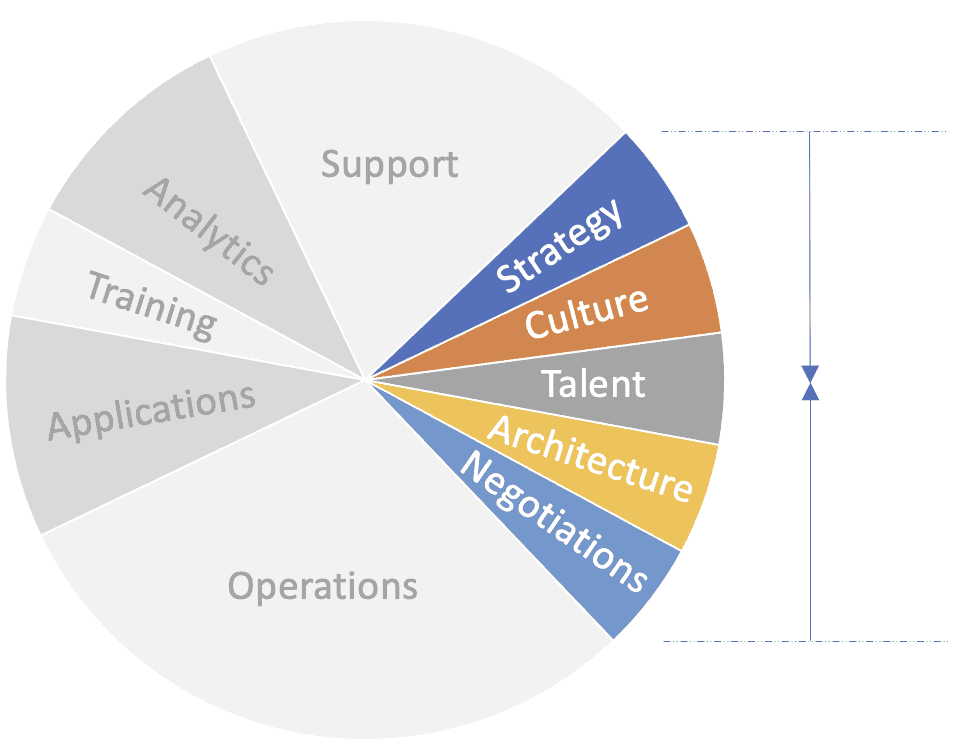The role of Chief Information Officer (CIO, or Chief Technology Officer, CTO) is among the most complex challenging roles in the C-suite. This is true whether a CIO accepts the role from a successor, inheriting a platform and organization (starting from which leadership no doubt expects them to deliver FAR greater things…), or even if they design a startup company’s IT from the ground up (being forced to support a growing organization in all the ways established companies are supported by IT, but starting at zero…)
CIOs’ calendars are likely to be filled with many meetings, and their to-do lists ever-growing at a rate faster than they can cross off items. Innovation Vista’s Fractional/Virtual CIO practice has given us a unique perspective on the activities of CIOs, and some insights we share below on which we believe are the five highest-leverage, i.e. the five activities where their expertise is most needed, and most impactful on the results for their organization.
We believe that ALL organizations would benefit greatly from an “experienced hand on the steering wheel” for these CIO activities, whether or not they need or can afford a full-time seasoned CIO (some do, and some don’t). Either way, mistakes on these activities can haunt an organization for decades, handicap its future potential, or even put it out of business completely. For that reason, companies would do well to leverage the absolute best experts they can engage to coordinate these functions:
Highest-Leverage doesn’t mean “Most Critical”
There are functions on the responsibilities lists of many CIOs which are “critical”, i.e. which if they’re not handled on a regular basis could spell doom for the organization, but which nonetheless are not listed in our “Highest-Leverage” lists here. Examples include operating a company’s systems day to day, ensuring that support requests are handled in a quality/timely manner, keeping systems patched and compliant with governance and cyber protections, ensuring company staff are trained on an organization’s systems & policies, etc. These are important functions, but they are not on our list.
Why? Because although these functions are critical, they don’t necessarily require (or benefit from) the expertise of a CIO. Wise CIOs delegate many of those other activities and monitor them with KPI & exception reports, etc. to keep their time and mental energy free for the items below; some organizations outsource these functions altogether. We’ve defined our list as “Highest-Leverage” and chosen only the CIO activities for which experience creates a sizable and meaningful spectrum of performance.
The differential in execution on the items below between excellence, mediocrity, and failure is enormous – literally multiple orders of magnitude in terms of costs, risks, capabilities, and benefits to the organization. Activities with that kind of “spread” on performance made the cut to appear in our top 5 list… …and without further ado, here they are:
#1 – Strategy
Strategy, along with Trust (see #2 Culture below), form the foundation underpinning our Innovation framework. It is key because it informs how a CIO approaches all of their activities. Strategy dictates the timing and necessity of certain decisions; moving up the priority on some, and deprioritizing others.
IT Strategy must align with, and ultimately empower, the overall organization’s strategy. What is the end goal of leadership? Has an M&A just occurred or is one likely in the future? Would the company be the entity seeking to grow by acquisition, or seeking to be acquired? Is the business’s competitive advantage high-touch/high-quality or low-cost/efficiency?
What is the competitive landscape like? Can & should some of the organization’s processes be fully autonomous or semi-autonomous, or is IT “behind the curtain” bringing key information to employees so they can deliver products & services most efficiently? How are competitors answering each of the questions above, and is there an opportunity to take market-share from any/all of them by answering differently?
It’s clear that IT Strategy must be set to some level of resolution at least before decisions can be made about approaching the other duties on a CIO’s plate…
#2 – Culture
An old quote from management guru Peter Drucker states that “Culture eats Strategy for breakfast”, but we believe that either in isolation will fail. It’s no accident then that Strategy and Culture are the first 2 “high-leverage” activities on our list.
Influencing culture is far better achieved by actions than with words, or with plaques tacked to the wall. Summaries of a shared culture can be useful, but only if the members’ (especially leaders’) actions are typically in alignment with those words. Culture begins with a CIO’s first interactions with their colleagues, staff, and vendors. As noted above, Trust is a foundational requirement for any level of success with IT; we coach CIOs to “Build Trust First” when joining an organization or initiating any kind of change.
Building from a foundation of trust, nurturing of Culture is critical to enable the team behaviors that will yield real Innovation. As we’ve noted previously, Innovation is an outgrowth of a Culture of Collaboration and Teamwork. Collaboration and Teamwork are different behaviors; each is valuable in different phases of ideation, decision-making, and execution. Expert CIOs know when each is called for, and have the skills to navigate the organization toward those behaviors. This is easier said than done, and many younger manager fall short on just this point; successful nurturing of Culture requires significant emotional intelligence and knowledge of both human nature and organizational behavior.
#3 – Talent
Jim Collins, in his great collection of success case studies “Good to Great”, found a pattern in most ultra-successful organizations that their leaders focused first on who was on the team, then on what they were aiming to accomplish: “First Who, Then What”. We’ve seen this concept deified, degenerating into a revolving-door never-ending-search for “perfect” team members, so some caution is needed, but the spirit of this motto is a good one. Certainly, focusing on the goals of a team while knowing some of the team members are not good fits is a doomed exercise more likely to run off the strong team members than the bad apples.
For CIOs, we counsel making recruiting a major priority. This means not just spending personal time screening and interviewing candidates for jobs at least 2 levels down on the org-chart, but also spending time coaching everyone in a management capacity on the importance of (and best approaches to) recruiting quality talent onto the team. Helping everyone to see the importance of the quality and “fit” of new-hires will only help engender a view that their department is a “special” place that not everyone is qualified to join, no matter how impressive their technical skills.
Vendors & outsourcing should be a strategic part of CIO’s staffing plans as well. Every situation is unique, but when a breadth of experience can be obtained more affordably, or when “surge” resourcing is needed, and/or “commodity” skills are sufficient and no unique organizational continuity is needed, outsourcing makes a lot of sense for many organizations.
Staff retention is certainly a key aspect of this “high-leverage activity” for CIOs (especially in the age of the “Great Resignation”), but we feel it’s best seen as a natural result of the notes above relating to culture & recruiting. Retention efforts which are ramped up in response to increased unintended staff loss are gimmicky and are usually greeted with the skepticism these “bolt-on efforts” deserve.
A quick note on firing staff: nothing demoralizes all-star employees more than seeing mediocre employees being allowed to a) stay mediocre (don’t hesitate to coach assertively) and b) stay in their role (don’t hesitate to demote/terminate underperformers if they don’t respond to coaching).
…and a note on compensation: corporate “annual increase” programs often chase away the most promising employees – young professionals who’ve got their feet under them and who’ve learned the company’s platform. This seems to be a larger issue in IT than in many other departments. The “value jump” (both market value and the value to the organization) of an IT pro in year 2 vs. year 1 is VASTLY different than the jump to year 22 vs. 21. Experienced staff in some skill-sets can be multiple times more productive than junior employees, not just marginally better.
Salary increase matrices which dictate maximum increases often slap younger employees in the face and drive them away (usually to large salary bumps). We encourage CIOs to lay these cards on the table with HR departments and the C-suite, and to request a pool of money equal to the corporate increase % for your entire department, and then use that hard-won flexibility to align compensation to your team members’ true values.
#4 – Architecture
IT is, after all, a technical discipline, and the key architectural decisions must be high enough on a CIO’s priority list to ensure that present and future needs of the company can be met by the platform. IT is also an extremely wide discipline, such that it’s far more difficult for a CIO to know all the details of all the job functions and systems administered by their department than, for example, a CMO or a CFO to know the details of all of the jobs in their departments. (A CEO and COO are better analogies for the breadth of complexity encompassed in the role.)
Thus, it is crucial that a CIO leverage technical experts in Cybersecurity, Infrastructure (Cloud & on-premise), Operations, Systems, Data, and Analytics. These experts can be on-staff in larger companies, or via vendor partners in SMBs with more modest budgets. Either way the experts are key partners which the CIO should use (and challenge) to ensure the company’s architectural positioning make sense for the company’s present and future:
- Security
- Capacity (current margin for flex, as well as future scalability)
- Performance
- Integration (ideally API/built-in modular N:1 and not “spider-web” N:N)
- Custom vs. Customized (PaaS) vs. Off-the-shelf systems (features/cost trade-offs)
- On-premise vs. Cloud SaaS/PaaS/IaaS
- High market-share platforms (for feature-climb and reduced risk of emergency migration)
#5 – Negotiation
Negotiating favorable terms is as important as choosing the right platforms. There are two distinct aspects of this function, the combination of which makes this our #5 highest-leverage activity of a CIO.
Firstly, there are skills applicable to any negotiation. Beyond rules of thumb like “always be willing to walk away” and “find the point at which the other side walks away”, there are myriad books on the topic, e.g. “Never Split the Difference“. Basic negotiating skills can be learned, but they are likely possessed by many across the organization.
More importantly for the CIO role, there are unique aspects of negotiating IT hardware, software, and services contracts specifically which are mainly learned on the job (sometimes the hard way, although there is one book on the topic we can recommend: The Tech Contracts Handbook). Tech vendors have certain rules for revenue recognition which often open opportunities for savings around quarter-end and year-end cutoff dates. They also play tricks such as licensing an entire group/company even during setup/configuration and customization phases, when (sometimes) it can be cheaper to start with a small # licenses for the implementation team, with a price-lock for scaling up for launch, and even future growth.
Another favorite trick often used by hardware and software vendors is to overcharge on implementation services which could be performed by internal staff or other vendor partners more vested in pricing fairly for the future relationship. Multi-module enterprise system providers love to upcharge customers who are already using one module when they come back for additional modules. And the list could go on and on…
All or most of these tricks and opportunities are solvable in contract negotiations, but one has to know what to ask for, and on which items the vendor is likely to have flexibility. This again is significant value-add for experienced CIOs who’ve been around these blocks and can ensure the best terms are achieved for the organization.
These 5 functions embody the highest-value elements of the CIO role
 These five activities: Strategy, Culture, Talent, Architecture, and Negotiation, represent the highest-leverage functions that a CIO performs – i.e. the highest, best use of their time. Some organizations may choose to engage a Virtual CIO to perform these functions on a part-time/fractional basis; others may be large enough and funded well enough to hire a full-time permanent CIO to handle these duties along with other IT leadership tasks, as time permits.
These five activities: Strategy, Culture, Talent, Architecture, and Negotiation, represent the highest-leverage functions that a CIO performs – i.e. the highest, best use of their time. Some organizations may choose to engage a Virtual CIO to perform these functions on a part-time/fractional basis; others may be large enough and funded well enough to hire a full-time permanent CIO to handle these duties along with other IT leadership tasks, as time permits.
Either way, given the huge leverage on these activities (the differential between poor and excellent performance), we strongly suggest that these five be set at the very top of a CIO’s priority list for personal involvement. Other IT leadership functions can be delegated and monitored; it’s on these items that a CIO really “earns their pay” and maximizes the strategic importance of the role to their organization.





